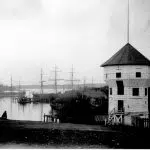
New funding helping Gabriola recycling group pull more clothing waste from landfill
GABRIOLA ISLAND — New funding from the Regional District of Nanaimo is set to trigger some major steps forward for a local textile recycling organization.
A total of $61,545 in zero waste grant funding was awarded to Gabriola Island Recycling Organization (GIRO) for their continued work in diverting and recycling textile waste in the community.
General manager Michelle Kresnyak said half the money will be put toward operational costs over the next year, while the remainder will help construction finish on their new building.
“The next steps are windows and doors and getting the roof on, the exterior cladding then all the finishing will happen after that. We hope if things continue to go the way they’re going right now, that we’ll complete at the end of January.”



